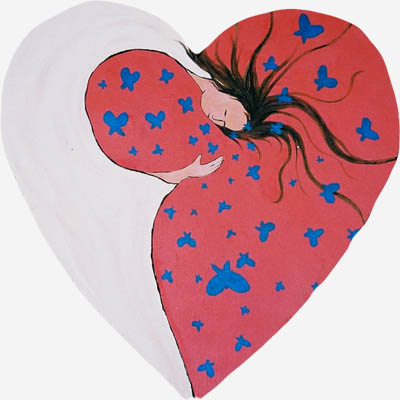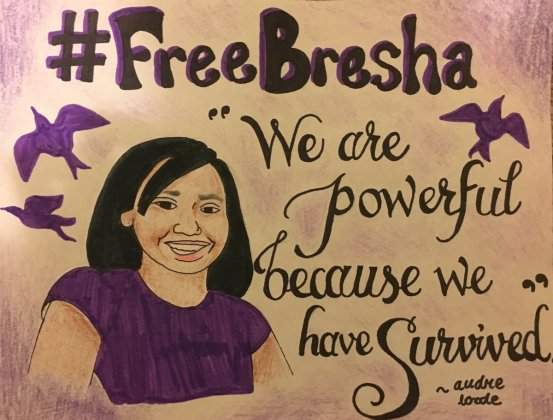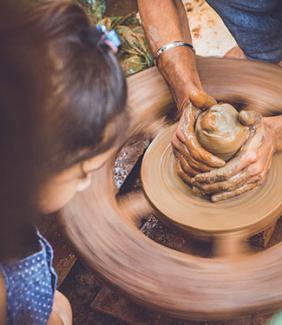by Breckan Erdman, NRCDV Program Specialist
When I was in college, I co-facilitated a weekly creative writing workshop at a local domestic violence shelter. “Writing workshop” was a loose term for our group, which gathered informally each week with residents who were available and interested to read and write poetry, play word games, talk about art, and listen to music. No one was required to attend; residents came because they wanted to. In a domestic violence program where the rest of the day was often highly structured and centered around managing crises, our weekly gatherings created a space for flexibility, creativity, and self-care.
Although some folks in the group knew themselves to be great poets and artists, many of us did not. Our gatherings were more about taking time to connect and create than about writing a perfect poem or short story. We often abandoned our set agendas to make space for storytelling. As we worked together to find meaning in poetry and shared our vulnerabilities when reading our own writings aloud, we built community.
Even if we don’t consider ourselves to be particularly “artistic,” most of us like to create in one way or another, whether this means writing poetry, performing in an improv group, gardening, or cooking food that brings us comfort. Because using the arts for self-expression can be incredibly empowering and can promote healing for survivors, making space to create and play can serve an important role in domestic violence organizations.
Art for Healing
“I found I could say things with color and shapes that I couldn’t say any other way – things I had no words for.” – Georgia O’Keefe
Different creative outlets, from music therapy to body art are known to promote healing for survivors of trauma. This can take a more structured form, such as art therapy, which is when a licensed mental health professional works with clients to “use art media, the creative process, and the resulting artwork to explore their feelings, reconcile emotional conflicts, foster self-awareness, manage behavior and addictions, develop social skills, improve reality orientation, reduce anxiety, and increase self-esteem” (American Art Therapy Association). Because it has the flexibility to “be molded and designed around each and every individual patient and issue, addressing not only the physical and mental aspects, but reaching deeper into the emotional and spiritual,” art therapy is particularly helpful for survivors of trauma. Researcher Sarah Riley writes that art therapy can be “an effective tool for expression, personal growth, and recovery from traumatic events and emotional weight” (Positive Effects of Art Therapy for Women and Children from Backgrounds of Domestic Violence).
 Even outside of the context of formal art therapy, it is easy to see the emotional benefits of engaging in expressive arts: working through frustrations while kneading clay, attaching words to lived experiences through poetry, navigating the world with someone else’s eyes through drama. And because art is inextricably intertwined with culture and identity, engaging in culturally significant forms of art can be an especially meaningful way for survivors to process and heal. Making space for creative expression can be an important part of providing empowering, culturally relevant services to survivors. INCITE! writes that art “helps us manifest our power and our vision into something real; it inspires and connects us to each other… Through culture we bring our vision alive, reclaim our histories and identities, and draw on the strength of our ancestors.”
Even outside of the context of formal art therapy, it is easy to see the emotional benefits of engaging in expressive arts: working through frustrations while kneading clay, attaching words to lived experiences through poetry, navigating the world with someone else’s eyes through drama. And because art is inextricably intertwined with culture and identity, engaging in culturally significant forms of art can be an especially meaningful way for survivors to process and heal. Making space for creative expression can be an important part of providing empowering, culturally relevant services to survivors. INCITE! writes that art “helps us manifest our power and our vision into something real; it inspires and connects us to each other… Through culture we bring our vision alive, reclaim our histories and identities, and draw on the strength of our ancestors.”
“For women, then, poetry is not a luxury. It is a vital necessity for our existence. It forms the quality of light from which we predicate our hopes and dreams toward survival and change, first into language, then into idea, then into more tangible action.” – Audre Lorde
And because it can help us to process feelings, express ourselves, and heal, creating art can be an empowering tool for self-care for advocates as we work to mitigate the effects of exposure to vicarious trauma and promote resilience in our work and personal lives. Even if you don’t consider yourself to be particularly artistic, doodling, journaling about your feelings, or simply manipulating a piece of clay with your hands can help you to soothe and center yourself. Or if you prefer more structure, you could engage in art therapy activities, such as assembling a motivational collage or creating a mind map, to help you process emotions, relax, and examine your sense of self.
Keep in mind that, although it’s wonderful to be able to create a breathtaking painting or to write a song that resonates with people, this is more about the process than the final product. The most important thing is to make space for self-expression, reflection and healing. Some ideas for incorporating the arts into domestic violence programs include:
- Add paint, clay, and other art supplies to your organization’s donation needs list. Keep these supplies in a place that is accessible for people to use when they feel inspired.
- Is there a blank wall in your building? Invite advocates and survivors in your organization to work together to create a mural.
- Offer incoming survivors a notebook and pen. This was a critical component of our weekly writing workshops – we tried to always have extra notebooks and pens available to give away, so that anyone interested in writing on their own time throughout the week had the supplies they needed.
- Gardening can be a great way to get in touch with nature and to create something beautiful at the same time, and has been shown to promote psychological and social well-being. Work with survivors in your program to start a garden or reach out to a local community garden.
- Reach out to your local community theatre or dance studio about opportunities to collaborate.
- If possible, connect with an art therapist in your area so you know who you can refer survivors to for art therapy.
- Ask the survivors and advocates in your organization what they like to do to express themselves creatively and try to find a way to build programming that is responsive to their artistic interests!
“I feel the gardening program has made my children become more gentle with plants and flowers, also they have learned all things grow with care and love.” – Survivor, Project GROW
For more information on the connections between, art, culture, and healing, as well as resources for service providers and a gallery of survivor artwork, visit Arte Sana’s website. Arte Sana is a national Latina-led nonprofit committed to ending sexual violence and other forms of gender-based aggressions and engage marginalized communities as agents of change through bilingual professional training, community education, and the arts.
Art for Social Change
“Political art is critical because it sparks critical reflection and consciousness for mass groups of peoples. It helps us manifest our power and our vision into something real.” – INCITE!
 In addition to its capacity to help us process our feelings and heal from trauma, art has the power to bring people together and foster social change. Because of its intrinsic ability to connect with people’s emotions and bring visibility to the lived experiences of marginalized communities, the arts have played a key role in virtually every social justice movement throughout history, from the freedom songs of the Civil Rights movement to Vietnam protest posters to the riot grrrl zines of the 1990s. Within the movement to end gender-based violence, survivors and activists have used the arts to raise awareness and move people to action through Clothesline Projects, Silent Witness Displays, the Bandana Project, and more. In recent years, efforts to support marginalized survivors who have been unjustly criminalized, such as the Free Marissa and Free Bresha campaigns, have harnessed the power of visual and literary arts through poster making, zines, and poetry to educate and create change.
In addition to its capacity to help us process our feelings and heal from trauma, art has the power to bring people together and foster social change. Because of its intrinsic ability to connect with people’s emotions and bring visibility to the lived experiences of marginalized communities, the arts have played a key role in virtually every social justice movement throughout history, from the freedom songs of the Civil Rights movement to Vietnam protest posters to the riot grrrl zines of the 1990s. Within the movement to end gender-based violence, survivors and activists have used the arts to raise awareness and move people to action through Clothesline Projects, Silent Witness Displays, the Bandana Project, and more. In recent years, efforts to support marginalized survivors who have been unjustly criminalized, such as the Free Marissa and Free Bresha campaigns, have harnessed the power of visual and literary arts through poster making, zines, and poetry to educate and create change.
So how can your program use the arts to inspire social change? The Domestic Violence Awareness Project offers ideas for traditional Domestic Violence Awareness Month campaign events that incorporate visual arts, such as purple ribbon campaigns, silent witness displays and brides marches. You could also consider engaging with your community through a story circle, working with youth in your community to design educational posters, or even staging a local production of the Vagina Monologues to raise awareness about gender-based violence. These are just a starting point – the possibilities are truly endless!
For more information:
- Arte Sana
- Transformative Storytelling for Social Change
- DO YOU: Building Youth Resilience Through Creative Expression
- How can I incorporate experiential or alternative activities into summer programming with domestic violence survivors? by Patty Branco, NRCDV
- Art for Action by the Northwest Network
- Using Story Circles to Capture Local Community Responses to Gender-Based Violence by NRCDV
Artwork:
My Soul Has Survived (Andrea Wellnetz, Arte Sana)
Free Bresha protest art















